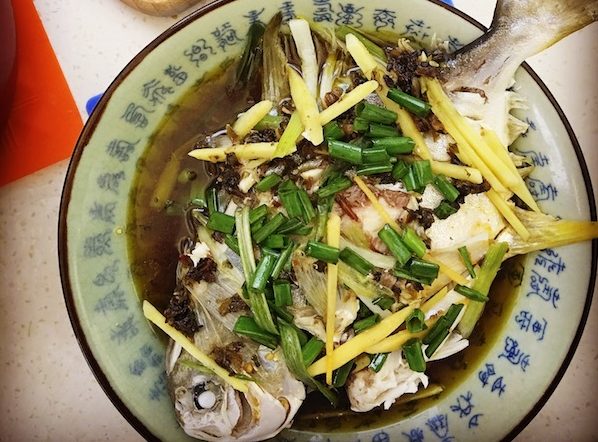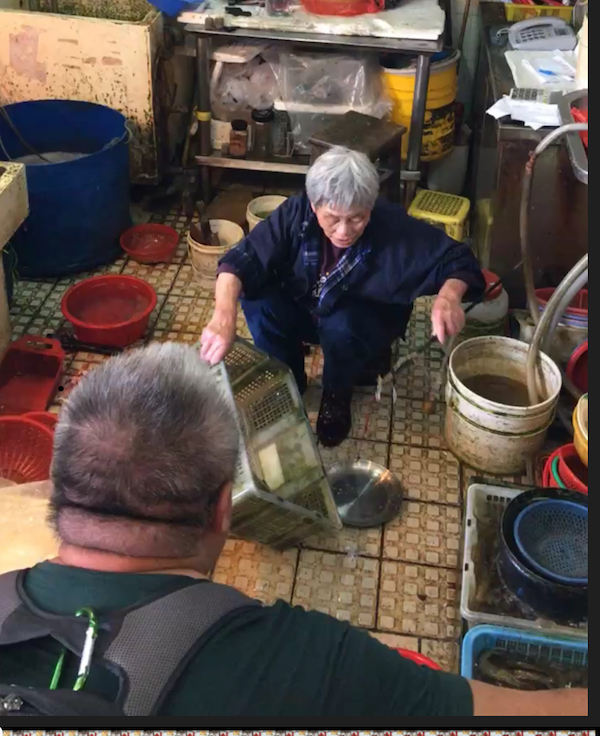
09 May Living Like a Local: A Perfect Steamed Fish Recipe
One of the questions our Little Adventures in Hong Kong guests often ask our director, Daisann McLane while on tour is: Do you cook Cantonese food? Here’s her (somewhat complicated) answer about how she’s learned to live like a local–and mastered one very important local cooking technique.
Confession time: While I love to cook, during my 14 years in Hong Kong I have not learned how to cook much Cantonese food. There’s a simple reason–as director of Little Adventures in Hong Kong, I spend most of my days and nights either guiding guests around to terrific Cantonese restaurants, noodle shops and street food. And when I’m not with guests, I’m out and about scouting for places that are fabulous but under the radar, looking for new restaurants, and exploring new areas and neighborhood foods.
My feeling was always, “Why do I need to learn to cook Cantonese food when I can stumble out of my door in Hong Kong, walk a few steps, and eat the world’s most delicious examples of this cuisien?
Then I moved to Peng Chau, a small Hong Kong island with very few restaurants (that all close on Monday), a rather crummy chain supermarket, and four small vegetable and fruit stands.
While Peng Chau island may not be rich in culinary variety by most measures, we punch way above our weight in one area: Fish. The island was originally settled by Chinese fishermen, and women, and many of their descendents (my neighbors!) are still here. The go out in the morning and afternoon, and bring back amazing fish and seafood from the waters around Hong Kong–I didn’t realize there is so much abundance, still, in these local waters!
Fortunately, the one Cantonese cooking technique I have mastered over these years (and possibly the most important of all the Cantonese cooking techniques) is the steaming of fresh whole fish. So when I’m stuck at home on a rainy Monday, and want to prepare a fresh, delicious and LOCAL meal, I do what the locals do: I head for the Peng Chau fish market to buy something from Mui Je (Sister Mui).
Living like a local: Daisann’s Cantonese Steamed Fish Recipe
There’s no big secret to steaming a fish Cantonese style–it just takes practice, the right equipment, and most importantly, the freshest possible ingredients.
Let’s start with ingredients:
I’m sorry to say that the most delicious versions of Cantonese steamed fish are going to be the ones that start with a live fish that has been freshly killed before your eyes. There is no substitute for this and anything less is going to result in an inferior dish. Cantonese cuisine is built around the flavor of freshness, and every dish in the cuisine is prepared in a way to maximize that. So if you live somewhere in the world where all the fish comes frozen, you’re just not going to get the same flavor and texture.
However, fresh fish that has been pre-killed will work! You just have to be extra careful to find a fish that hasn’t been sitting around too long. Check the eyes (they should be clear and kind of “hard” looking, not mushy or cloudy), and make sure you have a good relationship with your fishmonger.
Here on Peng Chau I’m very fortunate to have a relationship with one of the world’s best fish stall owners, Mui Je.
(Click on the image to see this amazing woman in action!)
Mui Je is a legend on Peng Chau, and she is the person who buys up most of the fish that my neighbors catch every morning. I’ve actually been there when they are unloading their daily catch to give to her. Now that is F-R-E-S-H.
I usually buy golden or white pomfret (in Cantonese, chong yu) from her, and I recommend that you start perfecting your steaming technique with pomfret for a number of reasons. First because it is a flat fish without too many bones. The thinness of the fish will make it easier for you to avoid over or understeaming the fish. Pomfret is also a versatile fish. It tastes good whether you decide to do the minimalist version of Cantonese steamed fish (green onions, ginger, oil and light soy sauce dressing), or if you want to get a bit more elaborate (black beans, or some kind of pre-packaged Cantonese cooking sauce), or if you really want to go off-reservation and steam your fish with Indian or Thai spices.
Choosing the fish: When it comes to steamed fish, you’re going to find that SMALL IS BETTER. For one thing, a thick or large fish will not fit into your pot so easily and it will cook unevenly. I would even recommend getting two smaller fish for a large crowd, rather than trying to get one big fish.
Besides the fish you are going to want to have on hand:
1. Green onions and slivered ginger
2. Soy sauce
3. Some kind of cooking oil (I like olive oil, but soybean or canola oil are probably more traditional)
4. Optional: dried black beans, or a jar of some sort of Cantonese cooking sauce–I highly recommend any of the lovely sauce pastes made by Mrs So, whose shop is a popular stop on our Little Adventures in Hong Kong Cook’s Tours.
Equipment: This is the fun part. Steaming a Cantonese fish is an immensely satisfying process because you actually put your fish on the plate you are planning to serve it on, and put the plate and the fish in the wok or steaming pot. When it is ready to roll, you use these handy plate tongs to remove the plate, and the fish, from the pot. It’s a big “voila” moment!

Oh–you’re also going to need some kind of tiny steaming rack to set in the bottom of your wok or pan. It should lift the plate comfortably above the level of the water that you’ll be putting in the bottom of the pan to create the steam that is going to cook your lovely fish. You don’t need a special rack or anything. I’ve even seen people set a pair of chopsticks across the bowl of a wok and place the fish in the dish on top of that “steamer”.
The only implement I find that’s really crucial here are the plate tongs. They make your steaming process way easier, so I do recommend going out of your way to find one (in Hong Kong they’re sold everywhere, and probably Chinatowns around the world will have them because they are as essential to Cantonese cooking as, well, good soy sauce.
Procedure:
Clean your fish, inside and out. (I actually rub some kind of lemon or lime with salt all over the inside and outside, then rinse and repeat.) Put the fish on the plate and dress it with your ginger slivers, and some green onion cut into short stalks. If you are using black beans or a cooking sauce, rub it over the top and back of your fish.
Put an inch and a half of water in your wok or pan, set the wok on the cooking fire, with you steaming tray/chopstick base inside, and wait for the water to boil. When it is boiling, put the plate with your dressed fish inside and COVER WITH A LID.
Wait at least 8 minutes. I know, it’s hard. But let it sit and cook for a bit before you succumb to the urge to lift the lid and peek.
Depending on the size and freshness of the fish, and your pan steaming setup, you may be done after 8 minutes! If not, let it go a bit further, checking after another 2 minutes or so . IMPORTANT: You do NOT need to turn the fish over. That’s the beauty of this cooking method.
As soon as you decide it’s ready (I often use a tiny knife to cut into the thickest part), take it out of the wok, place it on the counter, and get ready to do the final touch! Empty the water out of your wok, put in a little oil and some soy sauce. Heat it up for a minute until it’s warm and drizzle it over your fish. It should make a little sizzle sound (also very satisfying). You need to do this FAST, so that the fish is still steaming while you’re pouring the oil/soy sauce mixture on it. If you have a stove with two burners, then heat the oil and soy sauce in a separate pan before you take the fish off the fire. (I only have one burner in my Peng Chau kitchen because, well, I’m living like a local. Who has room for two burners?)
The tricky part, as with most things culinary, is the timing. It will take you a while to feel confident about how long to leave the fish in, and when to take it out. Even experienced cooks in Hong Kong fret over this step. (And if need be, know that you can always put the fish BACK in the steaming wok if the fish meat turns out to be not well done enough). A few years ago I made up my mind I was going to steam a fish from the market at least once every week, until I got the hang of it. I’ve practiced, I’m still not perfect, but every time I rock a fish out of the steamer and on to the table, I feel a little bit more like a legit Hong Konger.



